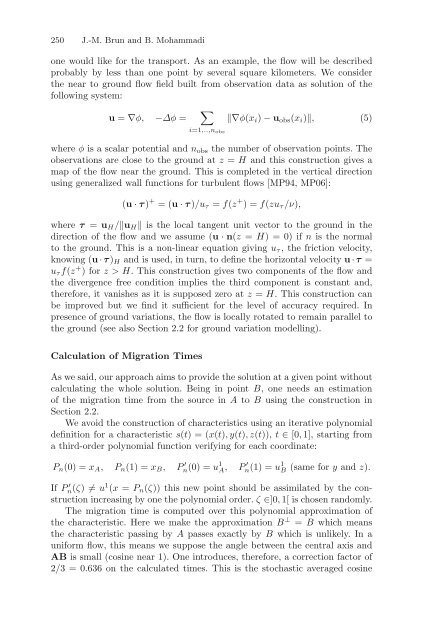Partial Differential Equations - Modelling and ... - ResearchGate
Partial Differential Equations - Modelling and ... - ResearchGate
Partial Differential Equations - Modelling and ... - ResearchGate
You also want an ePaper? Increase the reach of your titles
YUMPU automatically turns print PDFs into web optimized ePapers that Google loves.
250 J.-M. Brun <strong>and</strong> B. Mohammadi<br />
one would like for the transport. As an example, the flow will be described<br />
probably by less than one point by several square kilometers. We consider<br />
the near to ground flow field built from observation data as solution of the<br />
following system:<br />
u = ∇φ, −∆φ = ∑<br />
i=1,..,n obs<br />
‖∇φ(x i ) − u obs (x i )‖, (5)<br />
where φ is a scalar potential <strong>and</strong> n obs the number of observation points. The<br />
observations are close to the ground at z = H <strong>and</strong> this construction gives a<br />
map of the flow near the ground. This is completed in the vertical direction<br />
using generalized wall functions for turbulent flows [MP94, MP06]:<br />
(u · τ ) + =(u · τ )/u τ = f(z + )=f(zu τ /ν),<br />
where τ = u H /‖u H ‖ is the local tangent unit vector to the ground in the<br />
direction of the flow <strong>and</strong> we assume (u · n(z = H) =0)ifn is the normal<br />
to the ground. This is a non-linear equation giving u τ , the friction velocity,<br />
knowing (u · τ ) H <strong>and</strong> is used, in turn, to define the horizontal velocity u · τ =<br />
u τ f(z + )forz>H. This construction gives two components of the flow <strong>and</strong><br />
the divergence free condition implies the third component is constant <strong>and</strong>,<br />
therefore, it vanishes as it is supposed zero at z = H. This construction can<br />
be improved but we find it sufficient for the level of accuracy required. In<br />
presence of ground variations, the flow is locally rotated to remain parallel to<br />
the ground (see also Section 2.2 for ground variation modelling).<br />
Calculation of Migration Times<br />
As we said, our approach aims to provide the solution at a given point without<br />
calculating the whole solution. Being in point B, one needs an estimation<br />
of the migration time from the source in A to B using the construction in<br />
Section 2.2.<br />
We avoid the construction of characteristics using an iterative polynomial<br />
definition for a characteristic s(t) =(x(t),y(t),z(t)), t ∈ [0, 1], starting from<br />
a third-order polynomial function verifying for each coordinate:<br />
P n (0) = x A , P n (1) = x B , P ′ n(0) = u 1 A, P ′ n(1) = u 1 B (same for y <strong>and</strong> z).<br />
If P ′ n(ζ) ≠ u 1 (x = P n (ζ)) this new point should be assimilated by the construction<br />
increasing by one the polynomial order. ζ ∈]0, 1[ is chosen r<strong>and</strong>omly.<br />
The migration time is computed over this polynomial approximation of<br />
the characteristic. Here we make the approximation B ⊥ = B which means<br />
the characteristic passing by A passes exactly by B which is unlikely. In a<br />
uniform flow, this means we suppose the angle between the central axis <strong>and</strong><br />
AB is small (cosine near 1). One introduces, therefore, a correction factor of<br />
2/3 =0.636 on the calculated times. This is the stochastic averaged cosine
















